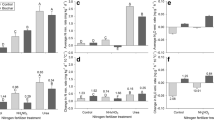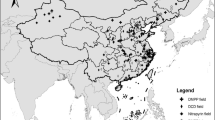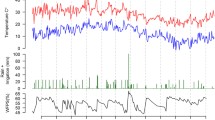Abstract
Purpose
Vegetable production is one of the most intensive agricultural systems with high rates of nitrogen (N) fertilizer use and irrigation, conditions conducive for nitrate (NO −3 ) leaching, and nitrous oxide (N2O) emissions. The objective of this study was to determine the effectiveness of a nitrification inhibitor, dicyandiamide (DCD), in decreasing NO −3 leaching and N2O emissions in vegetable production systems.
Materials and methods
Twenty-four undisturbed soil monolith lysimeters (610 mm in diameter; 700 mm in depth; surface area, 0.29 m2) with two different soils, Huangzongrang (alfisol) and Chaotu (fluvisols), were collected and installed in a field lysimeter facility in Central China under irrigated vegetable production conditions. Urea fertilizer was applied at 650 kg N ha−1, and DCD was applied at 10 kg ha−1 to the lysimeters planted with three kinds of vegetables (capsicum, Capsicum annuum L.; amaranth, Amaranthus mangostanus L.; radish, Raphanus sativus L.).
Results and discussion
The results showed that DCD reduced NO −3 leaching by 58.5% and 36.2% and N2O emissions factor by 83.8% and 72.7% in the two soils. The average NO −3 –N concentration in the drainage water was decreased from 4.9 mg N L−1 to 2.3 mg N L−1 and from 4.4 mg N L−1 to 3.3 mg N L−1, in the Huangzongrang and Chaotu soils, respectively. In addition to the environmental benefits, the use of DCD also increased the yields of capsicum and radish in alfisol soil significantly (P < 0.01); only the amaranth yield in fluvisol soil was declined (P < 0.01), and the other vegetables yields were not affected. Total N concentrations of the three vegetables were increased significantly (P < 0.01) with the application of DCD with urea compared with urea alone. These results showed that the nitrification inhibitor DCD has the potential to significantly reduce NO −3 leaching and N2O emissions and to make vegetable farming more environmentally friendly.
Conclusions
These results demonstrated that the use of the nitrification inhibitor DCD can significantly reduce NO −3 leaching, N2O emissions, and the average NO −3 –N concentration in the drainage water, while increasing the fertilizer N efficiency in the vegetable production system.




Similar content being viewed by others
Abbreviations
- NO −3 :
-
Nitrate
- N2O:
-
Nitrous oxide
- DCD:
-
Dicyandiamide
- N:
-
Nitrogen
- NI:
-
Nitrification inhibitor
References
Amberger A (1989) Research on dicyandiamide as a nitrification inhibitor and future outlook. Commun Soil Sci Plant Anal 20:1933–1955
Bao SD (2002) Soil and agricultural chemistry analysis, 3rd edn. China Agriculture Press, Beijing, pp 43–149
Cameron KC, Smith NP, McLay CDA, Farser PM, McPherson RJ, Harrion DF, Harbottle P (1992) Lysimeters without edge-flow: an improved design and sampling procedure. Soil Sci Soc Am J 56:1625–1628
Cao B, He FY, Xu QM, Yin B, Cai GX (2006) Denitrification losses and N2O emissions from nitrogen fertilizer applied to a vegetable field. Pedosphere 16(3):390–397
Di HJ, Cameron KC (2002a) Nitrate leaching and pasture production from different nitrogen sources on a shallow stony soil under flood-irrigated dairy pasture. Aust J Agric Res 40(2):317–334
Di HJ, Cameron KC (2002b) The use of a nitrification inhibitor, dicyandiamide (DCD), to reduce nitrate leaching and nitrous oxide emissions in a simulated grazed and irrigated grassland. Soil Use Manage 18:395–403
Di HJ, Cameron KC (2003) Mitigation of nitrous oxide emissions in spray-irrigated grazed grassland by treating the soil with dicyandiamide, a nitrification inhibitor. Soil Use Manage 19:284–290
Di HJ, Cameron KC (2004a) Treating grazed pasture soil with a nitrification inhibitor, eco-n™, to decrease nitrate leaching in a deep sandy soil under spray irrigation. N Z J Agric Res 47:351–361
Di HJ, Cameron KC (2004b) Effects of temperature and application rate of a nitrification inhibitor, dicyandiamide (DCD), on nitrification rate and microbial biomass in a grazed pasture soil. Aust J Soil Res 42(8):927–932
Di HJ, Cameron KC (2005) Reducing environmental impacts of agriculture by using a fine particle suspension nitrification inhibitor to decrease nitrate leaching from grazed pastures. Agric Ecosyst Environ 109:202–212
Di HJ, Cameron KC (2007) Nitrate leaching losses and pasture yields as affected by different rates of animal urine nitrogen returns and application of a nitrification inhibitor—a lysimeter study. Nutr Cycl Agroecosyst 79:281–290
Di HJ, Cameron KC, Sherlock RR (2007) Comparison of the effectiveness of a nitrification inhibitor, dicyandiamide (DCD), in reducing nitrous oxide emissions in four different soils under different climatic and management conditions. Soil Use Manage 23:1–9
Di HJ, Cameron KC, Shen JP, Winefield CS, O'Callaghan M, Bowatte S, He JZ (2009) Nitrification driven by bacteria and not archaea in nitrogen rich grassland soils. Nat Geosci 2:621–624
Di HJ, Cameron KC, Shen JP, Winefield CS, O'Callaghan M, Bowatte S, He JZ (2010) Ammonia oxidizing bacteria and archaea grow under contrasting soil nitrogen conditions. FEMS Microbiol Ecol 72:386–394
Dobbie K, Smith K (2003) Nitrous oxide emission factors for agricultural soils in Great Britain: the impact of soil water-filled pore space and other controlling variables. Glob Chang Biol 9:204–218
Fang SX, Mu YJ (2006) Air/surface exchange of nitric oxide between two typical vegetable lands and the atmosphere in the Yangtze Delta, China. Atmos Environ 40:6329–6337
Flores P, Castellar I, Navarro J (2005) Nitrate leaching in pepper cultivaton with organic manure and supplementary additions of mineral fertilizer. Commun Soil Sci Plant Anal 36:2889–2898
He FF, Chen Q, Jiang RF, Chen XP (2007) Yield and nitrogen balance of greenhouse tomato (Lycopersicum esculentum Mill.) with conventional and site-specific nitrogen management in northern China. Nutr Cycl Agroecosyst 77:1–14
He FF, Jiang RF, Chen Q, Zhang FS, Su F (2009) Nitrous oxide emissions from an intensively managed greenhouse vegetable cropping system in Northern China. Environ Pollut 157:1666–1672
Hutchinson GL, Mosier AR (1981) Improved soil cover method for field measurement of nitrous oxide fluxes. Soil Sci Soc Am J 45:311–316
Intergovernmental Panel on Climate Change (IPCC) (2001) Climate change 2001: the scientific basis. In: Houghton JT, Ding Y, Griggs DJ, Noguer M, Van der Linden PJ (eds) Contribution of working group I to the Third Assessment Report of the Intergovernmental Panel on Climate Change. Cambridge University Press, Cambridge, UK and New York
Intergovernmental Panel on Climate Change (IPCC) (2007) Chapter 8: Agriculture. In: Metz B, Davidson O, Bosch P, Dave R, Meyer L (eds) Climate change 2007: mitigation. Contribution of working group III to the fourth assessment report of the Intergovernmental Panel on Climate Change. Cambridge University Press, Cambridge, UK and New York
Ju XT, Kou CL, Zhang FS, Christie P (2006) Nitrogen balance and groundwater nitrate contamination: comparison among three intensive cropping systems on the North China Plain. Environ Pollut 143:117–125
Kraft GJ, Stites W (2003) Nitrate impacts on groundwater from irrigated-vegetable systems in a humid north-central US sand plain. Agric Ecosyst Environ 100:63–74
Ledgard SF, Penno JW, Sprosen MS (1999) Nitrogen inputs and losses from clover/grass pastures grazed by dairy cows, as affected by nitrogen fertilizer application. J Agric Sci Camb 132:215–225
McCarty GW, Bremner JM (1989) Laboratory evaluation of dicyandiamide as a soil nitrification inhibitor. Commun Soil Sci Plant Anal 20:2049–2065
Mosier AR, Kroeze C (2000) Potential impact on the global atmospheric N2O budget of the increased nitrogen input required to meet future global food demands. Chemosph Glob Change Sci 2:465–473
Mosier AR, Kroeze C, Nevison C, Oenema O, Seitzinger S, VanCleemput O (1998) Closing the global N2O budget: nitrous oxide emissions through the agricultural nitrogen cycle. Nutr Cycl Agroecosyst 52:225–248
Muller C, Sherlock RR, Williams PH (1998) Field method to determine N2O emission from nitrification and denitrification. Biol Fertil Soils 28:51–55
National Bureau of Statistics of P.R. China (2009) China statistical yearbook. China Statistics Press, Beijing, Chapter 12
Pain BF, Misselbrook TH, Rees YJ (1994) Effects of nitrification inhibitor and acid addition to cattle slurry on nitrogen losses and herbage yields. Grass Forage Sci 49:209–215
Ramos C, Agut A, Lidon AL (2002) Nitrate leaching in important crops of the Valencian Community region (Spain). Environ Pollut 118:215–223
Rogers GA, Penny A, Hewitt MV (1985) Effect of nitrification inhibitors on uptake of mineralised nitrogen and on yields of winter cereals grown on sandy soil after ploughing old grassland. J Sci Food Agric 36:915–924
Sun ZM, Wu ZJ, Chen LJ, Yong G (2006) Research advances in nitrogen fertilization and its environmental effects. Chinese J Soil Sci 37(4):782–786 (in Chinese with English summary)
Thomas S, Meike B, Gotz E (2007) An integrative method to quantify contaminant fluxes in the groundwater of urban areas. J Soils Sediments 7(4):261–269
Topcu S, Kirda C, Dasgan Y, Kaman H, Cetin M, Yazici A, Bacon MA (2007) Yield response and N-fertiliser recovery of tomato grown under deficit irrigation. Eur J Agron 26:64–70
Weiske A, Benckiser G, Herbert T, Ottow JCG (2001) Influence of the nitrification inhibitor 3,4-dimethylpyrazole phosphate (DMPP) in comparison to dicyandiamide (DCD) on nitrous oxide emissions, carbon dioxide fluxes and methane oxidation during 3 years of repeated application in field experiments. Biol Fertil Soils 34:109–117
Williamson JC, Taylor MD, Torrens RS, Vojvodic-Vukovic M (1998) Reducing nitrogen leaching from dairy farm effluent-irrigated pasture using dicyandiamide: a lysimeter study. Agric Ecosyst Environ 69:81–88
Yadav SN (1997) Formulation and estimation of nitrate–nitrogen leaching from corn cultivation. J Environ Qual 26:808–814
Zhao CS, Hu CX, Huang W, Sun XC, Tan QL, Di HJ (2010) A lysimeter study of nitrate leaching and optimum nitrogen application rates for IIVPS in Central China. J Soils Sediments 10:9–17
Zheng X, Huang Y, Wang M (2003) Seasonal characteristics of nitric oxide emission from a typical Chinese rice-wheat rotation during the non-waterlogged period. Glob Chan Biol 9:219–227
Acknowledgments
The project was funded by the 948 Project from the Ministry of Agriculture of China (grant no. 2008-Z25) and the National Key Project of science and technology (2008BADA7B03).
Author information
Authors and Affiliations
Corresponding author
Additional information
Responsible editor: Thomas DeLuca
Rights and permissions
About this article
Cite this article
Cui, M., Sun, X., Hu, C. et al. Effective mitigation of nitrate leaching and nitrous oxide emissions in intensive vegetable production systems using a nitrification inhibitor, dicyandiamide. J Soils Sediments 11, 722–730 (2011). https://doi.org/10.1007/s11368-011-0357-0
Received:
Accepted:
Published:
Issue Date:
DOI: https://doi.org/10.1007/s11368-011-0357-0




